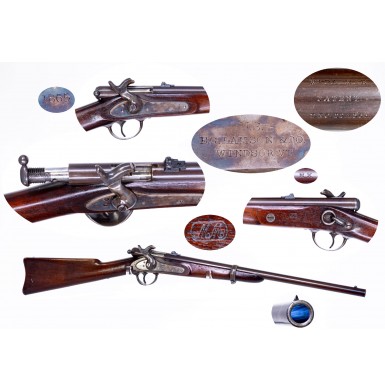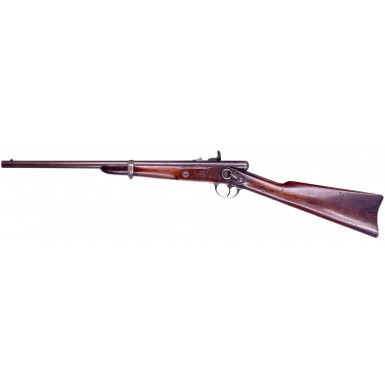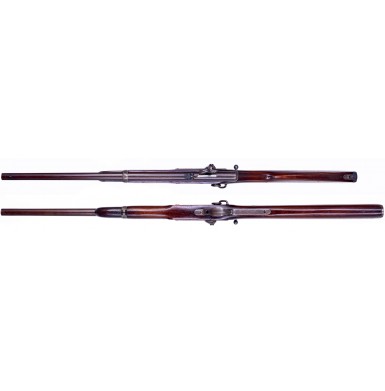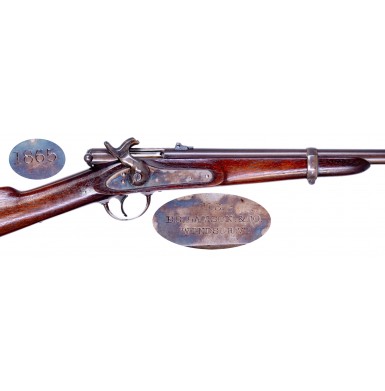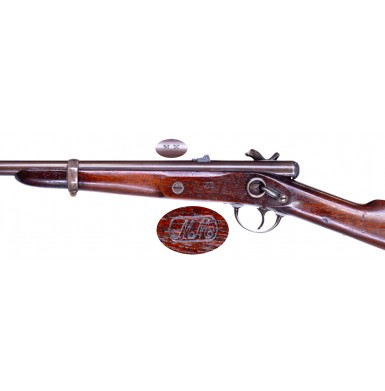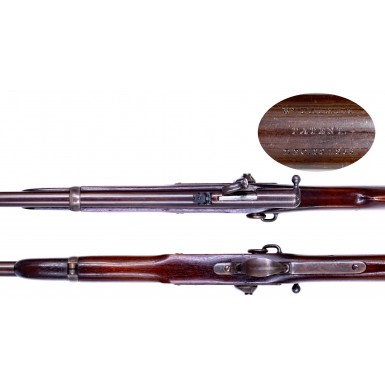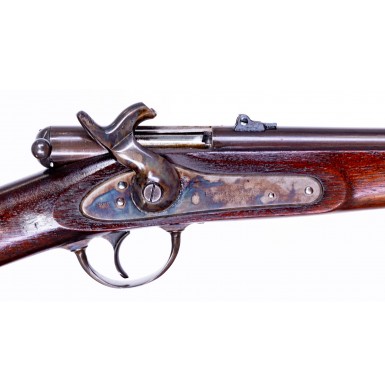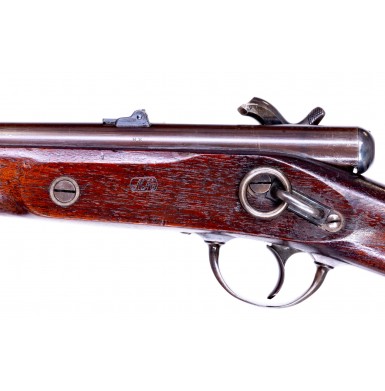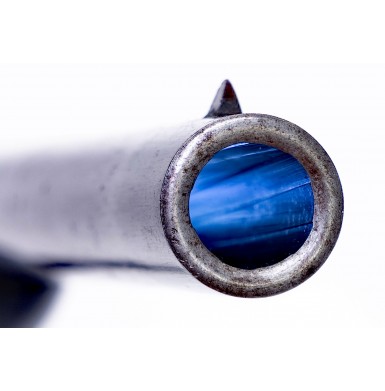This is a VERY FINE condition example of the scarce Palmer Carbine. The Palmer Carbine has the unique distinction of the being the first bolt-action, metallic cartridge firearm accepted for US military service, and in fact was first firearm of that style to be produced in any quantity anywhere in the world. William R. Palmer of New York invented the gun. Palmer received US Patent #41,017 patent for the bolt-action design on December 22, 1863. Palmer had initially worked as a gunsmith in New York, having been listed in the local directories from 1848 - 1864. Palmer also held a US patent for a tilting breech carbine design that was sort of a Hall and Lindner hybrid (#32,887 July 23, 1861), as well as two revolver patents (#21,623 September 28, 1858 & #41,857 March 8, 1864). This design was a single shot, bolt-action carbine with a simple and effective bolt locking system. The rear of the bolt was cut with 9 coarse (9 TPI) interrupted threads. After the carbine hammer was placed on half-cock, a quarter turn of the small handle at the rear of the bolt, from horizontal to vertical, disengaged the threads and allowed the bolt to be manually retracted. A hook extractor on the bolt would pull the cartridge case out of the breech, making it contact a spring-loaded ejector, and tossing the round free of the receiver. A new round could then be inserted in the receiver and the bolt pushed home to chamber it. Turning the bolt handle 90-degrees to the right, from vertical to horizontal, locked the breech of the carbine. The hammer could then be fully cocked to fire the gun or left in the “half-cock” or “safe” position. This same basic interrupted thread locking system would form the basis of the locking system for most breechloading artillery for the next 100+ years.
In the initial design, the chambering of the carbine was .44RF but due to the Ordnance Department’s adoption of the newly standardized .50RF Government Cartridge (56-50 Spencer) cartridge, the chambering of the guns was altered to .50RF. The Palmer design was initially tested by the US military in September and October of 1863. According to the testing officers, the most impressive feature of the design was its ability to automatically eject spent cartridges from the gun simply through the operation of the bolt. The Ordnance Department was sufficiently impressed with the testing to place an order for 1,000 of the carbines on June 20, 1864. As Palmer was unable to produce the carbines, he entered into an arrangement with E.G. Lamson & Company of Windsor, VT to produce the guns. Palmer sold Lamson his patent rights in order to produce the guns. Lamson had been a principle in the firm of Lamson, Goodnow & Yale (LG&Y), which had been organized in 1861 to produce rifle muskets on contract for the US government. Lamson, Goodnow & Yale had purchased the majority of the assets of the defunct Robbins & Lawrence Company also of Windsor, VT. Robbins & Lawrence had ended up declaring bankruptcy due to contract for British Pattern 1853 Enfield Rifle Muskets that had been entered into with the British during the Crimean War. Due to the unforeseen rapid end of the war, the British cancelled the contract leaving the firm with a huge investment in machinery, raw materials, and a variety of parts in various stages of completion on hand. L.G.&Y. eventually acquired much of the tooling and machinery necessary to produce rifle muskets. L.G.&Y. became one of three firms, along with Colt and Amoskeag, to produce the “Special Model” Model 1861 rifle musket for the US government, which were a sort of Enfield / Springfield hybrid that had many Enfield features and was easier to produce on the machinery they already had. In 1864 Goodnow & Yale left the firm, and Lamson took sole control.
Lamson not only produced the Palmer patent carbine, but also produced the equally rare Ball Patent carbine, during the same time. Due to manufacturing delays, which resulted from the specified caliber change from .44RF to .50RF, the only Palmer carbine to be delivered prior to the end of the Civil War was a sample gun that had been delivered in May of 1864 in order to help secure the contract. The 1,000 contracted carbines were all delivered on June 15, 1865, some five weeks after General Robert E. Lee surrendered at Appomattox Court House.
The end of the Civil War meant that there would be no additional US military contracts for his designs, so Palmer embarked for Europe where he tried unsuccessfully to market his carbine. Palmer made several trips to the continent, and actually died in Germany a few years after the Civil War. Arms historians such as John McAulay have noted that some of his design innovations were utilized in the Krag and Mauser designs that helped define warfare at the end of the 19th and well into the 20th century.
The Palmer carbine, as delivered, was a single shot, metallic cartridge, bolt-action carbine, chambered in .50 Rimfire Government. The gun had a 20” round barrel and was 36” in overall length. The barrel was secured by a single clamping barrel band of the Model 1861 “Special Model” type, and with a screw that entered the bottom of the receiver, concealed by the triggerguard. A simple, L-shaped aperture rear sight was utilized, with the lowest leaf graduation being 100 yards, and with the pierced taller leaf being graduated for 300 and 500 yards. The sight is quite similar to the Whitney Arms Company “Mid-Range” sight, found on many of their “Good & Serviceable” rifles and rifle muskets. A short sling bar with a sling ring was mounted on the flat opposite the lock. The guns were finished with browned barrels, not blued as many reference books note, and had color casehardened locks and hammers. Much of the iron furniture was, like the buttplate browned as well.
This particular Palmer Carbine is in about VERY FINE condition. The gun is mechanically excellent, very crisp and retains about 80%+ of its original thinning browned finish on the barrel. The barrel shows moderate amounts of finish thinning along its length, with some streaky loss around the breech area and some minor wear along the high edges and contact points for handling the carbine. The lock retains a similar amount of the vivid case colors and is very striking. The majority of the furniture retains about 80% of its original finish, as well. The lock of the carbine is crisply dated 1865behind the hammer and in three lines forward of the hammer:
U.S.
E.G. LAMSON & CO
WINDSOR, VT.
The top of the receiver is marked in three lines:
WM PALMER
PATENT
DEC. 22, 1863
The counterpane of the stock, opposite the lock, is marked with a very crisp script MM cartouche, the mark of armory sub-inspector Miles Moulton. His MM marking in small block letters is also present on the top of the stock comb and on the left side of the barrel’s breech. Many of the smaller parts like the hammer, the buttplate tang, triggerguard, triggerguard tang are all marked with a sub-inspectors’ P mark. The carbine is mechanically excellent. The bolt functions smoothly and correctly and hammer locks crisply into both the half-cock and full-cock positions, responding to the trigger, as it should. The original rear sight is present and functions smoothly as well. The original sling bar and ring are present on the flat, opposite the lock. The metal of the gun is almost entirely smooth, with only some very minute pinpricking present around the breech, just forward of where the hammer strikes the exposed portion of the .50 rimfire cartridge rim. The bore of the carbine is about VERY FINE to NEAR EXCELLENT and remains mostly bright with crisp rifling. The stock of the carbine rates VERY FINE. The shows the usual scattered bumps, dings and mars from handling and storage that would be expected on a military arm that is more than 150 years old. However, it shows no abuse and no indications of having been sanded.
Overall, this is a really attractive, untouched, and unmolested example of the first military bolt action metallic cartridge arm to be accepted and ordered by the US military. Beyond the historical significance and influence of the design, the fact that only 1,001 were produced make the Palmer Carbine very scarce. This is one of those important “bookend” carbines that bridges the gap from the end of the American Civil War and starts the age of modern US military weapons. No advanced collection of US Civil War carbines or US bolt action martial arms is complete without one of these scarce and very attractive guns.

